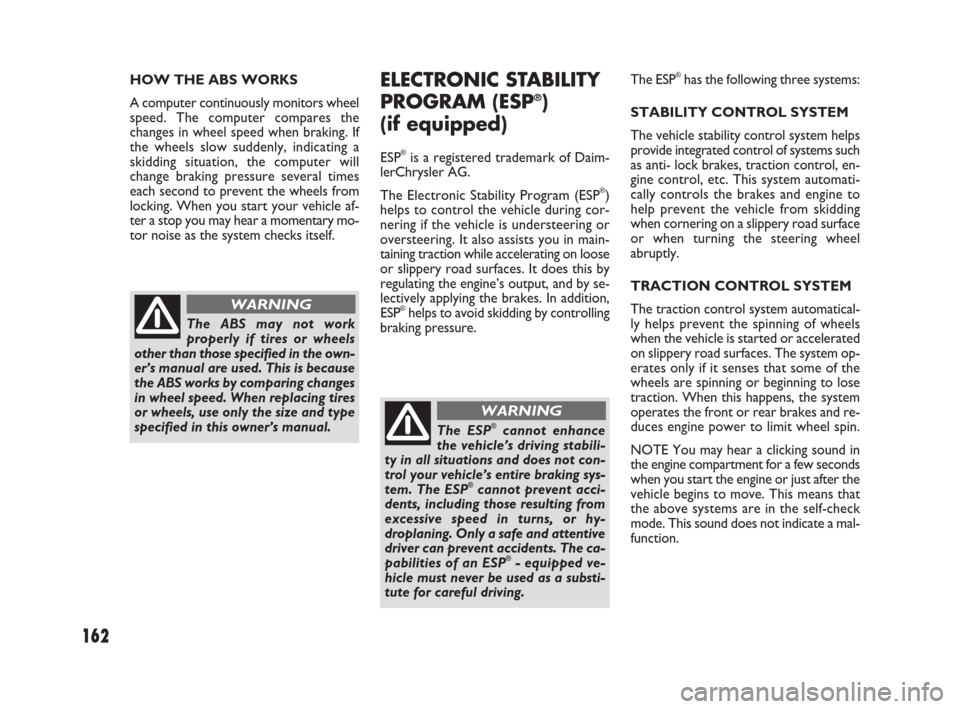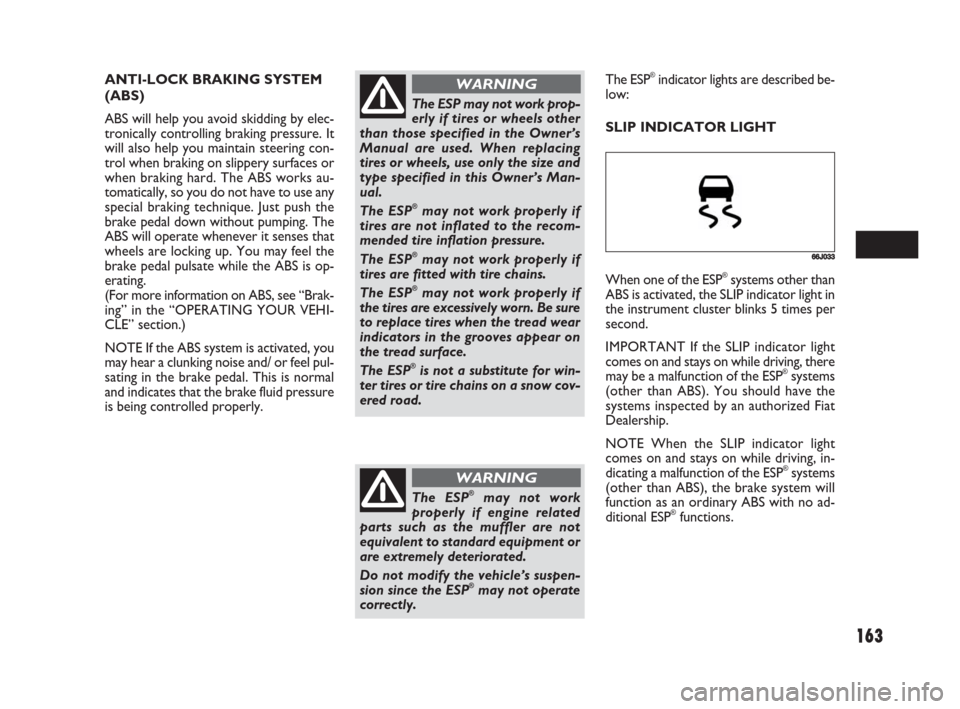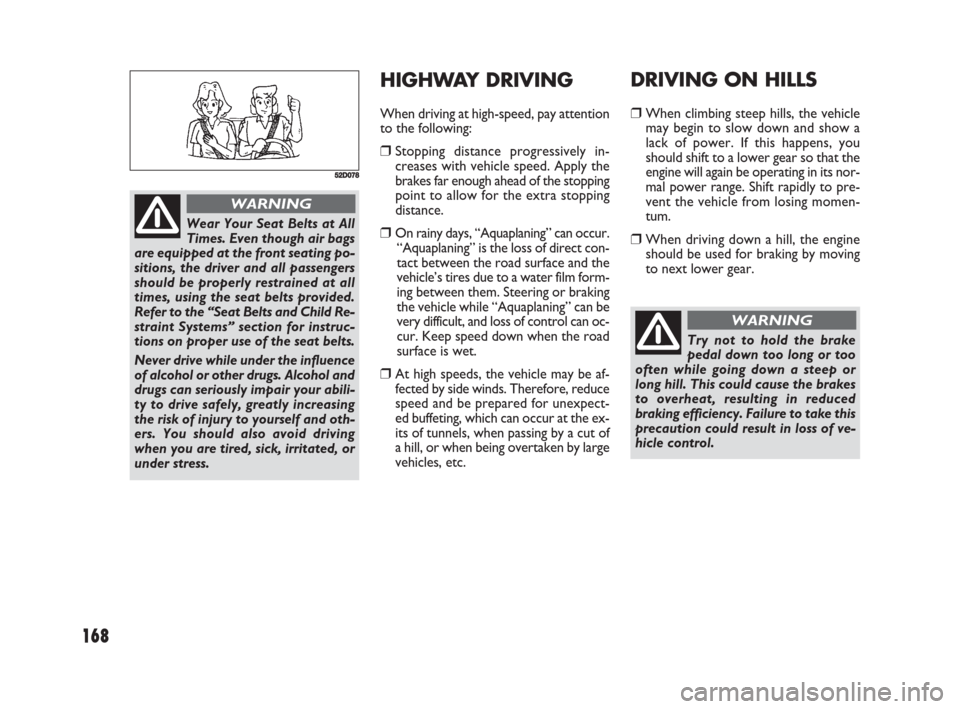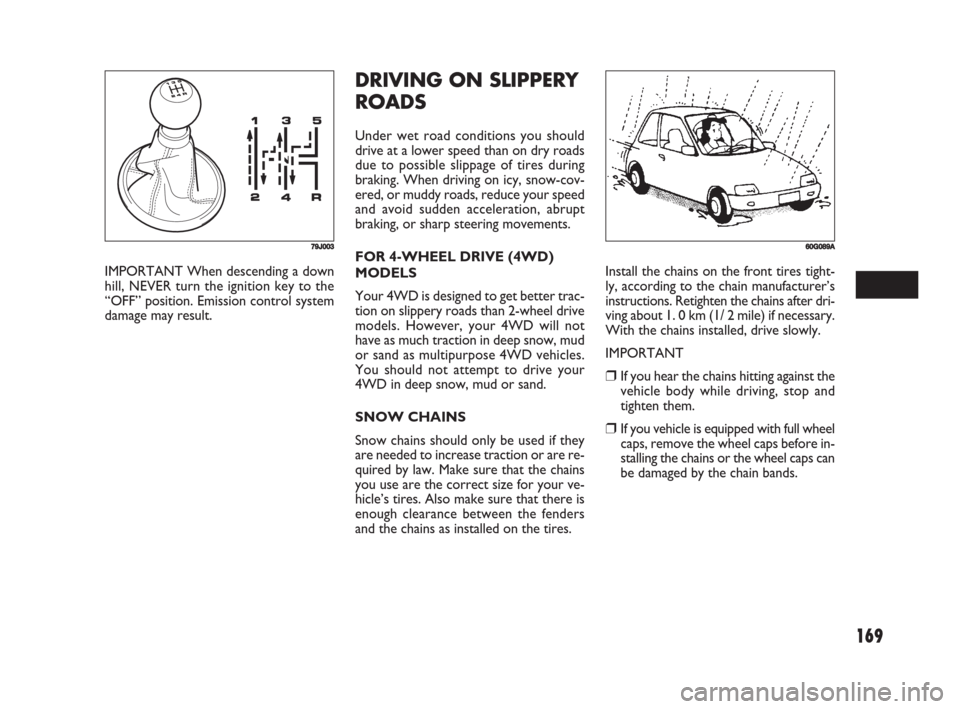2008 FIAT SEDICI steering
[x] Cancel search: steeringPage 163 of 266

162
HOW THE ABS WORKS
A computer continuously monitors wheel
speed. The computer compares the
changes in wheel speed when braking. If
the wheels slow suddenly, indicating a
skidding situation, the computer will
change braking pressure several times
each second to prevent the wheels from
locking. When you start your vehicle af-
ter a stop you may hear a momentary mo-
tor noise as the system checks itself.
The ABS may not work
properly if tires or wheels
other than those specified in the own-
er’s manual are used. This is because
the ABS works by comparing changes
in wheel speed. When replacing tires
or wheels, use only the size and type
specified in this owner’s manual.
WARNING
ELECTRONIC STABILITY
PROGRAM (ESP®)
(if equipped)
ESP®is a registered trademark of Daim-
lerChrysler AG.
The Electronic Stability Program (ESP
®)
helps to control the vehicle during cor-
nering if the vehicle is understeering or
oversteering. It also assists you in main-
taining traction while accelerating on loose
or slippery road surfaces. It does this by
regulating the engine’s output, and by se-
lectively applying the brakes. In addition,
ESP
®helps to avoid skidding by controlling
braking pressure.
The ESP®cannot enhance
the vehicle’s driving stabili-
ty in all situations and does not con-
trol your vehicle’s entire braking sys-
tem. The ESP
®cannot prevent acci-
dents, including those resulting from
excessive speed in turns, or hy-
droplaning. Only a safe and attentive
driver can prevent accidents. The ca-
pabilities of an ESP
®- equipped ve-
hicle must never be used as a substi-
tute for careful driving.
WARNING
The ESP®has the following three systems:
STABILITY CONTROL SYSTEM
The vehicle stability control system helps
provide integrated control of systems such
as anti- lock brakes, traction control, en-
gine control, etc. This system automati-
cally controls the brakes and engine to
help prevent the vehicle from skidding
when cornering on a slippery road surface
or when turning the steering wheel
abruptly.
TRACTION CONTROL SYSTEM
The traction control system automatical-
ly helps prevent the spinning of wheels
when the vehicle is started or accelerated
on slippery road surfaces. The system op-
erates only if it senses that some of the
wheels are spinning or beginning to lose
traction. When this happens, the system
operates the front or rear brakes and re-
duces engine power to limit wheel spin.
NOTE You may hear a clicking sound in
the engine compartment for a few seconds
when you start the engine or just after the
vehicle begins to move. This means that
the above systems are in the self-check
mode. This sound does not indicate a mal-
function.
149-166 Fiat16 New GB 3-09-2008 8:15 Pagina 162
Page 164 of 266

163
The ESP may not work prop-
erly if tires or wheels other
than those specified in the Owner’s
Manual are used. When replacing
tires or wheels, use only the size and
type specified in this Owner’s Man-
ual.
The ESP
®may not work properly if
tires are not inflated to the recom-
mended tire inflation pressure.
The ESP
®may not work properly if
tires are fitted with tire chains.
The ESP
®may not work properly if
the tires are excessively worn. Be sure
to replace tires when the tread wear
indicators in the grooves appear on
the tread surface.
The ESP
®is not a substitute for win-
ter tires or tire chains on a snow cov-
ered road.
WARNING
The ESP®may not work
properly if engine related
parts such as the muffler are not
equivalent to standard equipment or
are extremely deteriorated.
Do not modify the vehicle’s suspen-
sion since the ESP
®may not operate
correctly.
WARNING
ANTI-LOCK BRAKING SYSTEM
(ABS)
ABS will help you avoid skidding by elec-
tronically controlling braking pressure. It
will also help you maintain steering con-
trol when braking on slippery surfaces or
when braking hard. The ABS works au-
tomatically, so you do not have to use any
special braking technique. Just push the
brake pedal down without pumping. The
ABS will operate whenever it senses that
wheels are locking up. You may feel the
brake pedal pulsate while the ABS is op-
erating.
(For more information on ABS, see “Brak-
ing” in the “OPERATING YOUR VEHI-
CLE” section.)
NOTE If the ABS system is activated, you
may hear a clunking noise and/ or feel pul-
sating in the brake pedal. This is normal
and indicates that the brake fluid pressure
is being controlled properly.The ESP®indicator lights are described be-
low:
SLIP INDICATOR LIGHT
66J033
When one of the ESP®systems other than
ABS is activated, the SLIP indicator light in
the instrument cluster blinks 5 times per
second.
IMPORTANT If the SLIP indicator light
comes on and stays on while driving, there
may be a malfunction of the ESP
®systems
(other than ABS). You should have the
systems inspected by an authorized Fiat
Dealership.
NOTE When the SLIP indicator light
comes on and stays on while driving, in-
dicating a malfunction of the ESP
®systems
(other than ABS), the brake system will
function as an ordinary ABS with no ad-
ditional ESP
®functions.
149-166 Fiat16 New GB 3-09-2008 8:15 Pagina 163
Page 169 of 266

168
HIGHWAY DRIVING
When driving at high-speed, pay attention
to the following:
❒Stopping distance progressively in-
creases with vehicle speed. Apply the
brakes far enough ahead of the stopping
point to allow for the extra stopping
distance.
❒On rainy days, “Aquaplaning” can occur.
“Aquaplaning” is the loss of direct con-
tact between the road surface and the
vehicle’s tires due to a water film form-
ing between them. Steering or braking
the vehicle while “Aquaplaning” can be
very difficult, and loss of control can oc-
cur. Keep speed down when the road
surface is wet.
❒At high speeds, the vehicle may be af-
fected by side winds. Therefore, reduce
speed and be prepared for unexpect-
ed buffeting, which can occur at the ex-
its of tunnels, when passing by a cut of
a hill, or when being overtaken by large
vehicles, etc.
DRIVING ON HILLS
❒When climbing steep hills, the vehicle
may begin to slow down and show a
lack of power. If this happens, you
should shift to a lower gear so that the
engine will again be operating in its nor-
mal power range. Shift rapidly to pre-
vent the vehicle from losing momen-
tum.
❒When driving down a hill, the engine
should be used for braking by moving
to next lower gear.
52D078
Wear Your Seat Belts at All
Times. Even though air bags
are equipped at the front seating po-
sitions, the driver and all passengers
should be properly restrained at all
times, using the seat belts provided.
Refer to the “Seat Belts and Child Re-
straint Systems” section for instruc-
tions on proper use of the seat belts.
Never drive while under the influence
of alcohol or other drugs. Alcohol and
drugs can seriously impair your abili-
ty to drive safely, greatly increasing
the risk of injury to yourself and oth-
ers. You should also avoid driving
when you are tired, sick, irritated, or
under stress.
WARNING
Try not to hold the brake
pedal down too long or too
often while going down a steep or
long hill. This could cause the brakes
to overheat, resulting in reduced
braking efficiency. Failure to take this
precaution could result in loss of ve-
hicle control.
WARNING
167-170 Fiat16 New GB 3-09-2008 8:15 Pagina 168
Page 170 of 266

169
DRIVING ON SLIPPERY
ROADS
Under wet road conditions you should
drive at a lower speed than on dry roads
due to possible slippage of tires during
braking. When driving on icy, snow-cov-
ered, or muddy roads, reduce your speed
and avoid sudden acceleration, abrupt
braking, or sharp steering movements.
FOR 4-WHEEL DRIVE (4WD)
MODELS
Your 4WD is designed to get better trac-
tion on slippery roads than 2-wheel drive
models. However, your 4WD will not
have as much traction in deep snow, mud
or sand as multipurpose 4WD vehicles.
You should not attempt to drive your
4WD in deep snow, mud or sand.
SNOW CHAINS
Snow chains should only be used if they
are needed to increase traction or are re-
quired by law. Make sure that the chains
you use are the correct size for your ve-
hicle’s tires. Also make sure that there is
enough clearance between the fenders
and the chains as installed on the tires.Install the chains on the front tires tight-
ly, according to the chain manufacturer’s
instructions. Retighten the chains after dri-
ving about 1. 0 km (1/ 2 mile) if necessary.
With the chains installed, drive slowly.
IMPORTANT
❒If you hear the chains hitting against the
vehicle body while driving, stop and
tighten them.
❒If you vehicle is equipped with full wheel
caps, remove the wheel caps before in-
stalling the chains or the wheel caps can
be damaged by the chain bands. IMPORTANT When descending a down
hill, NEVER turn the ignition key to the
“OFF” position. Emission control system
damage may result.
79J00360G089A
167-170 Fiat16 New GB 3-09-2008 8:15 Pagina 169
Page 180 of 266

179
79J130
TOWING METHOD B
FROM THE FRONT:
FOUR WHEELS ON THE GROUND
B: 2WD VEHICLES WITH
MANUAL TRANSAXLE
❒Shift the manual transaxle lever into
neutral.
❒Turn the ignition key to the “ACC” po-
sition to unlock the steering wheel.
❒Release the parking brake.
IMPORTANT The steering column is not
strong enough to withstand shocks trans-
mitted from the front wheels during tow-
ing. Always unlock the steering wheel be-
fore towing.
B: 4WD VEHICLES WITH
MANUAL TRANSAXLE
❒Shift the 2WD/4WD switch to the
“2WD” mode.
❒Shift the manual transaxle lever into
neutral.
❒Turn the ignition key to the “ACC”
position to unlock the steering wheel.
❒Release the parking brake.
IMPORTANT The steering column is
not strong enough to withstand shocks
transmitted from the front wheels dur-
ing towing. Always unlock the steering
wheel before towing.
IMPORTANT Never use a towing truck
to tow 4WD vehicles.
79J17579J176
171-180 Fiat16 New GB 3-09-2008 8:42 Pagina 179
Page 182 of 266

181
I I
N N
S S
P P
E E
C C
T T
I I
O O
N N
A A
N N
D D
M M
A A
I I
N N
T T
E E
N N
A A
N N
C C
E E E
60G410
MAINTENANCE SCHEDULE ........................................... 183
MAINTENANCE RECOMMENDED UNDER SEVERE
DRIVING CONDITIONS .................................................... 188
DRIVE BELT .......................................................................... 189
ENGINE OIL AND FILTER ................................................ 189
GEAR OIL .............................................................................. 193
ENGINE COOLANT .......................................................... 195
WINDSHIELD WASHER FLUID ...................................... 198
AIR CLEANER ...................................................................... 198
SPARK PLUGS (Petrol engine).......................................... 199
FUEL FILTER (Diesel engine)............................................. 201
BRAKES .................................................................................. 202
STEERING .............................................................................. 204
CLUTCH PEDAL ................................................................. 205
TIRES ....................................................................................... 205
BATTERY ............................................................................... 210
FUSES ...................................................................................... 212
BULB REPLACEMENT ........................................................ 218
WINDSCREEN - REAR WINDOW WASHER /
WIPERS .................................................................................. 223
AIR CONDITIONING SYSTEM ....................................... 224
8
181-224 Fiat16 New GB 3-09-2008 8:17 Pagina 181
Page 186 of 266

185
15 30 45 60 75 90 105 120 135 150 165 180
●● ●●●●
●●●● ●●●●●●●
●●●●
● ●●●● ●●●●●●●
●● ●● ●● ●●
●●●●
●●●●
●●
●●●●
●●
●●●●
●●●●●●
●● ●●
●
●● ●●●●
●● ●●●●
●● ●●●●
●● ●●●●
● ●●●● ●●●●●●●
Thousands of km
Check exhaust emissions/smoke
Check cleanness of bonnet and boot locks and lever
cleanness and lubrication
Change spark plugs (change iridium spark plugs every 105,000 km)
Change engine oil and oil filter
Check air cleaner conditions
Replace air cleaner cartridge
Change engine coolant
Change accessory drive belt conditions
Sight inspect fuel tank conditions
Check manual transaxle gear oil level
Change manual transaxle gear oil
Check transmission unit oil level (4x4 version)
Check rear differential oil level (4x4 version)
Change rear differential oil (4x4 version)
(just the first time at 15,000 km)
Check suspension operation
Check steering system (electric drive)
Check engine control system operation
(through diagnostic socket)
Change brake and clutch fluid (or every 2 years)
Change pollen filter (or every 2 years)
181-224 Fiat16 New GB 3-09-2008 8:17 Pagina 185
Page 188 of 266

187
15 30 45 60 75 90 105 120 135 150 165 180
(●)(●)(●)(●)(●)(●)
●● ●● ●● ●●
●●●●
●●●●
●
●
●●●
●●●●
●
●●●●
●●●●●●
●●●●●
●
●● ●●●●
●● ●●●●
●● ●●●●
●● ●●●●
● ●●●● ●●●●●●●
Thousands of km
Change engine oil and oil filter (Diesel versions - DPF)**
Check air cleaner conditions
Replace air cleaner cartridge
Change engine coolant
Change accessory drive belt conditions
Change timing belt *
Change fuel filter
Sight inspect fuel tank conditions
Check manual transaxle gear oil level
Change manual transaxle gear oil
Check transmission unit oil level (4x4 version)
Check rear differential oil level (4x4 version)
Change rear differential oil (4x4 version)
(just the first time at 15,000 km)
Check suspension operation
Check steering system (electric drive)
Check engine control system operation
(through diagnostic socket)
Change brake and clutch fluid (or every 2 years)
Change pollen filter (or every 2 years)
* Or every 4 years in the event of particularly demanding use (cold climates, driving in the city, idling for a long time, driving on dusty
roads or covered with sand and/or salt), or in any case every 5 years regardless of the km covered.
** Actual interval to change engine oil and oil filter depends on the conditions of use of the vehicle and it is indicated by the relevant in-
strument panel warning light (see section “Warning and indicator lights”), or in any case every 2 years.
181-224 Fiat16 New GB 3-09-2008 8:17 Pagina 187